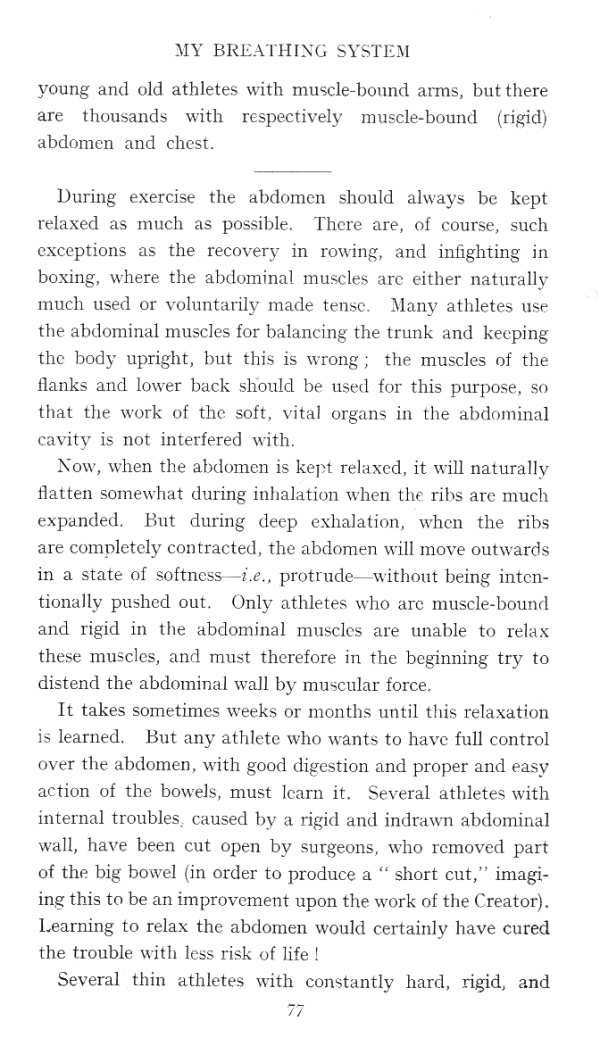33470 mbs 077

MY BREATHING SYSTEM
young and old athletes with muscle-bound arms, butthere are thousands with respectively muscle-bound (rigid) abdomcn and chcst.
During exercise tlie abdomcn should always be kept relaxed as much as possible. Thcre are, of course, such exceptions as the recovery in rowing, and infighting in boxing, where the abdominal muscles arc either naturaUy much used or voluntarily madę tensc. Many athletes use the abdominal muscles for balancing the trunk and keeping the body upright, but this is wrong; the muscles of the flanks and lower back should be used for this purpose, so that the work of the soft, vital organs in the abdominal cavity is not interfered with.
Now, when the abdomcn is kept relaxed, it will naturally flatten somewhat during inhalation when the rihs are much expanded. But during deep exhalation, when the ribs are completcly contracted, the abdomen will move outwards in a State of softness -i.e., protrude without being inten-tionally pushed out. Only athletes who arc muscle-bound and rigid in the abdominal muscles are unable to relax these muscles, and must therefore in the beginning try to distend the abdominal wali by muscular force.
It takes sometimes weeks or months until this relaxation is learned. Btit any athlete who wants to havc fuli control over the abdomen, with good digestion and proper and easy action of the bowels, must learn it. Several athletes with internal troubles caused by a rigid and indrawn abdominal wali, have been cut open by surgeons, who rcmoved part of the big bowel (in order to produce a “ short cut," imagi-ing this to be an improvement upon the work of the Creator). Learning to relax the abdomen would certainly have cured the trouble with less risk of life !
Several thin athletes with constantly hard, rigid, and
Wyszukiwarka
Podobne podstrony:
mbs 084 MY BREATHING SYSTEM tliercfore, to be performed with the l)ody in difterent positions. At Wh
mbs 011 MY BREATHING SYSTEM and violent palpitatiops. Sncli an overstrained licart could never last
mbs 014 MY BREATHING SYSTEM slow, regular respiration, even during the hardcst and most protracted e
mbs 022 MY BREATHING SYSTEM against the invasion and throw ol f thc gernis, which arc ejected with t
mbs 035 MY BREATHING SYSTEM How to Expand and Contract the Thorax to its fullest Extent The thoracic
mbs 068 MY BREATHING SYSTEM I think I was the first author who prescribed exactly, in each single cx
mbs 098 MY BREATHINT. SYSTEM EXERCISE No. 7. Fuli breathing during twisting and leaning to alternate
więcej podobnych podstron